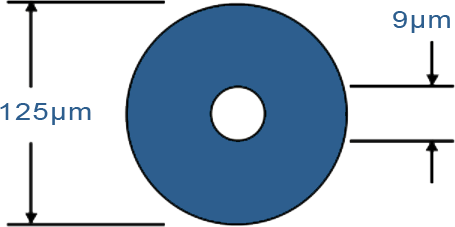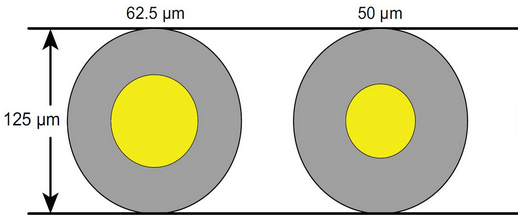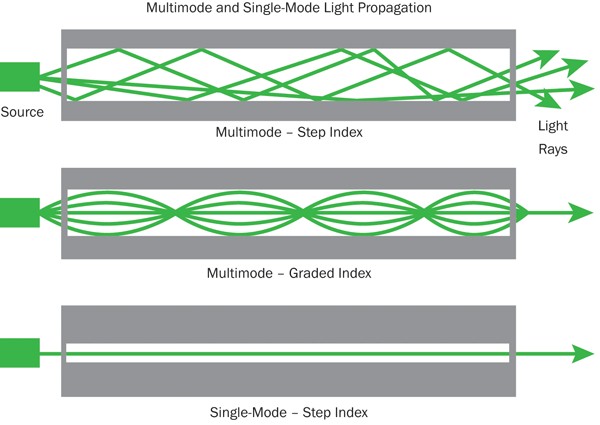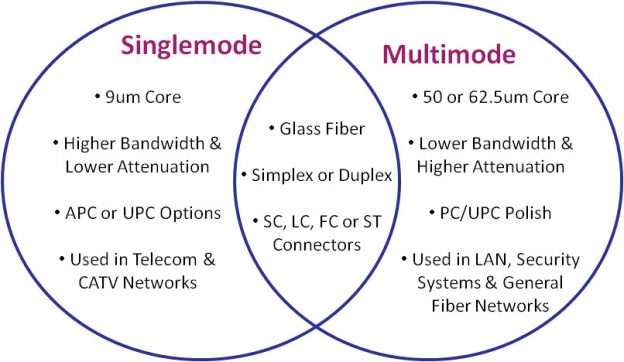When planning to build a fiber optic network, the first decision you often encounter is single mode fiber or multimode fiber. Hopefully, I can make that decision easier for you by explaining the differences between the two, and why you should choose one over the other.
To make a better choice, we’d better have an overall understanding of single mode fiber and multimode fiber respectively.
Generally, single mode fibers have a small core size (less than 10 µm) that permits only one mode or ray of light to be transmitted typically 1310 or 1550nm. For this reason, there is little light reflection created when light passes through the single mode fiber core. This will lower fiber attenuation and create the ability for the signal to travel further. Thus single mode fibers usually used in long distance, higher bandwidth applications.
Multimode fibers have larger cores (62.5 µm or 50 µm) that guide many modes simultaneously, which means more data can pass through the multimode fiber core at a given time. This will create more light reflections and higher dispersion and attenuation rate, reducing quality of the signal over long distances. Generally, multimode fibers are used in short distance, data and audio/video applications in LANs.
As mentioned above, the inner structure of single mode and multimode fibers are diverse, this naturally leads to the following differences:
The light propagation between single mode fiber and multimode fiber is totally different. Multimode fiber has two types of light propagation—step index and graded index, while single mode fiber has only one step index. And the light propagation reduces less in the single mode fibers transmission than that of multimode fibers.
Single mode fiber needs to be used with laser diode based fiber optic transmission equipment for precise calibration required to inject light into the fiber optic cable. While Multimode fiber is usually used with LED based fiber optic equipment for short distance transmissions. In addition, single mode connectors used for single mode fiber also have higher stringent alignment requirements than that of multimode fiber connectors.
Single mode fiber cable systems are usually more expensive even though the actual cost of single mode fiber cable is cheaper than that of multimode fiber cable in the market. This is because it is the optics that dominates the total cost of a network system. For example, single-mode transceivers cost 1.5 to 4 – 5 times more than multimode transceivers, depending on data rate. For more knowledge of deployment cost difference of single mode and multomode fiber, you can read this article: Single-mode Cabling Cost vs. Multimode Cabling Cost.
Further more, multimode transceivers also consume less power than single-mode transceivers. In a large data center with thousands of links, a multimode fiber cabling solution can provide substantial cost savings from both fiber transceiver and power/cooling perspective.
When selecting single mode fiber or multimode fiber, the most important thing to consider is the distance requirement. Within a data center, it’s typical to use multimode fibers which can get you 300-400 meters. If you have very long runs or are connecting over longer distance, single mode fiber can get you 10km, 40km, 80km, and even farther. You just need to use the appropriate optics for the distance required, and again, the prices go up accordingly. It is estimated that the transmission costs of multimode fiber, including both transmitter and receiver sides, will be in the range of $ 500 to $ 800. And the transmission systems designed for use with single mode fiber will typically cost more than $ 1000.
Note: single mode fiber and multimode fiber are not compatible. You cannot mix multimode and single mode fiber between two endpoints. The optics are not compatible either.
Generally, multimode fiber is more cost-effective choice for data center applications up to 550 meters. Single mode fiber is best used for distances exceeding 550 meters. Besides the transmission distance, the overall cost should also be taken into consideration. Whether single mode fiber or multimode fiber, choosing the one that best suits your network is the smartest choice. Nowadays, there is a trend for single mode cabling. Lots of data centers and providers will only do single mode cabling for new installs. So single mode fiber or multimode fiber, what’s your favor?
Related Article: Single Mode Fiber: How Much Do You Know?




